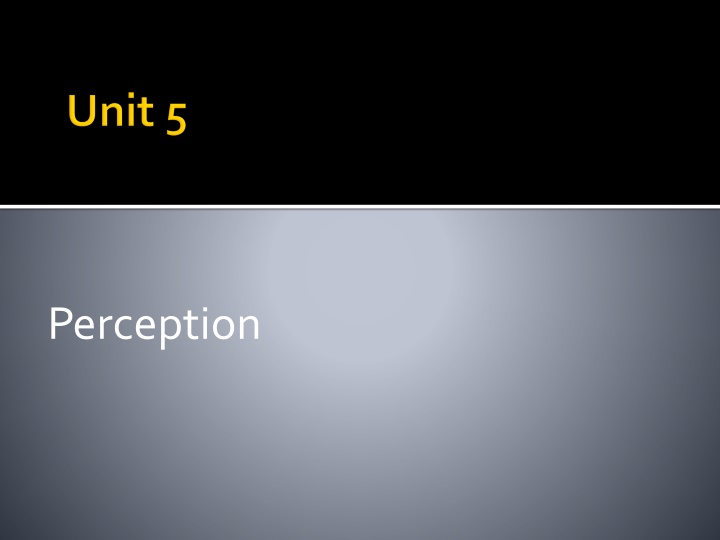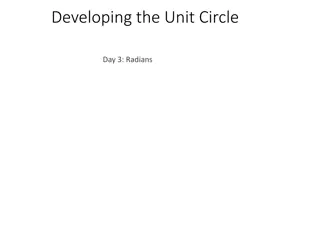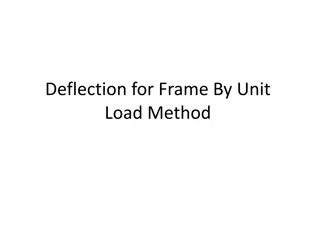
Understanding Perception: The Psychology of Interpretation and Behavior
Explore the intricacies of perception and how it shapes our interpretations, behaviors, and interactions with the world. From perceptual organization to errors and remedies, delve into the dynamic process of processing sensory data and attaching meaning to it. Discover the influence of perception on interpersonal relationships, organizational dynamics, and applications in various contexts.
Download Presentation

Please find below an Image/Link to download the presentation.
The content on the website is provided AS IS for your information and personal use only. It may not be sold, licensed, or shared on other websites without obtaining consent from the author. If you encounter any issues during the download, it is possible that the publisher has removed the file from their server.
You are allowed to download the files provided on this website for personal or commercial use, subject to the condition that they are used lawfully. All files are the property of their respective owners.
The content on the website is provided AS IS for your information and personal use only. It may not be sold, licensed, or shared on other websites without obtaining consent from the author.
E N D
Presentation Transcript
Introduction Perceptual Organisation PerceptualSets and PerceptualWorlds Halo EffectandStereotyping Attributions Selectivity and Perceptual
Perception: Errors and Remedies Interpersonal Perception Perception and Organisations its Application in
We interpretations,values and aims toouractions. What we do in the world depends on how we understand our place in it, depends on how we perceive ourselves and our social and physical environment, depends on how we perceive our circumstances. humans seem to attach meanings,
We explain behaviour with terms like reason', motive', intention', purpose', desire'and so on.
We process and interpret the incoming raw data in the light of our experiences, in terms of our current needs and interests, in terms of our knowledge, expectations, beliefs and motives. Perception may be defined as the dynamic psychological process attending to, organising and interpreting sensorydata. responsible for
From a psychological point of view, the process of sensation, on the one hand, and perception, on the other, work together through what are bottom-up' and top-down'processing. termed respectively
Perception is a dynamic process because it involves ordering and attaching meaning to raw sensory data. Our sensory apparatus is bombarded with vast amounts of information.
We are constantly sifting and sorting this stream of information, making interpretingit. Therefore, it can be said that perception is an information-processing activity. sense of it and
Theinternalfactorsaffectingperceptionare: Learning: Our past experience leads to the development of perceptual expectations or perceptual sets which give us predispositions to perceive and to pay attention to some stimuli and toignore otherinformation.
Theinternalfactorsaffectingperceptionare: Personality: Our predispose us to perceive the world in particular ways, to pay attention to some issues and events and human characteristics and not others. personality traits also
Theinternalfactorsaffectingperceptionare: Motivation: We are more likely to perceive as important, and thus to respond to, stimuli that find motivating.
We have seen how the perceptual process selects incoming stimuli and organises them into meaningful patterns. This processing is influenced by learning, motivation and personality - factors which give rise toexpectations.
These expectations, in turn, make us more ready to respond to certain stimuli in certain ways and lessready torespondtoothers. This readiness to respond individual's perceptual set. is called the
A perceptual set is an individual's predisposition torespondtoevents in a particularmanner. Aperceptualsetisalso known as a mental set. As we tend to perceive what we expect to perceive, this can also be called our perceptual expectations.
For example, one well-known piece of research compared the pace of life in six countries (Britain, Italy, Indonesia, Japan, Taiwan and the UnitedStates)bymeasuring: Theaccuracyofclocksincity bankbranches, The speed at which city pedestrians walked, and The length of time it took to buy a postage stamp.
Japanese cities had the most accurate clocks, the fastest pedestrians and the most efficient post officeclerks. Indonesian cities had the least accurate clocksandtheslowestpedestrians. Italyhadtheslowestpost officeclerks. To change an individual's behaviour - change their perceptions through the information and experiencesavailabletothem.
The concept of perceptual set or perceptual expectation applies to the ways in which we see otherpeople,events and objects. To understand the nature of perception is to understand, at least in part, the sources and natureof many organisational problems.
There are two related and prominent features of the process of people perception: the halo effect and stereotyping.
One conditions under which the halo effect is most marked: 1. when the traits to be perceived are unclear in behaviouralexpressions 2. When the traits encounteredbytheperceiver,and 3. whenthetraitshavemoralimplications. classic research study noted three are not frequently
Attribution is the process by which we make sense of our environment through our perceptionsofcausality. An attribution, therefore, is a belief about the causeor causesofaneventor anaction. Fritz Heider and Harold Kelley developed attribution theory during the 1950s and 1960s.
They stated that our understanding of our social world is based on our continual attempts at causal analysis based on how we interpret our experience.
The main sources of errors in perception include thefollowing: 1. Not collecting enough information about other people. 2. Basing our judgements on information that is irrelevant or insignificant.
The main sources of errors in perception include thefollowing: 3. Seeing what we expect to see and what we want toseeand notinvestigating further. 4. Allowing early information about someone to affect our judgement contradictoryinformation. despite later and
The main sources of errors in perception include thefollowing: 5. Acceptingstereotypesuncritically. 6. Allowing our own characteristics to affect what weseein othersand how wejudgethem.
The main sources of errors in perception include thefollowing: 7. Attempting to decode non-verbal behaviour outside thecontextin which it appears. 8. Basing attributions on flimsy and potentially irrelevant evidence.
Thus, it is clear that errors in perception can be overcomeby: 1. Taking more time and avoiding instant or snap judgementsabout others. 2. Collecting and consciously information about otherpeople. using more
Thus, it is clear that errors in perception can be overcomeby: 3. Developing self-awareness understanding of how our personal biases are preferences affect judgements of otherpeople. and an our perceptions and
Thus, it is clear that errors in perception can be overcomeby: 4. Checking our attributions - particularly the links we make between aspects of personality and appearance on the one hand and behaviour on theother.
Adrian Furnham (1997) argues that the process of making evaluations, judgements or ratings of the performance of employees is subject to a numberof systematicperceptionerrors. This is particularly problematic in a performance appraisalcontext.
Theseare: Centraltendency Contrasterror Differentfrom me Halo effect Horn effect Initial impression Latestbehaviour Lenientor generous rating
Theseare: Performancedimension error Same as me Statuseffect Strictrating
Interpersonal perception of another person, an awareness and appraisal of his attitudes, attributes, intentions and theirlikely reactions toone'sactions. perception begins with the
Research was conducted by Zalking and Costello for better understanding perception. of interpersonal
The specific characteristics of the perceiver, accordingtothemare: 1. Knowing oneself makes it easier to see other accurately. 2. One's own characteristics characteristicsheislikely toseein others. affect the
The specific characteristics of the perceiver, accordingtothemare: 3. The person who accepts himself is more likely to be able to see favourable aspects of other people. 4. Accuracyin perceivingothersisnot a single skill.
characteristicsofthepersonbeing perceived are: 1. The status of the person perceived will greatly influence other'sperceptionofhim. 2. The person being perceived is usually placed into categories to perceptual activities. Two common categories arestatusand role. 3. The visible traits of the person will greatly influence the perceptionof him. simply the viewer s
People in organisations are always assessing others. Managers must appraise their subordinate's performance, evaluate how co-workers are working. When a new person joins a department he or she is immediately assessed by the other persons.
These organisation. EmploymentInterview PerformanceAppraisals AssessingLevel of Effort AssessingLoyalty have important effect on the
Implications of Perception on Performance andSatisfaction Productivity AbsenteeismandTurnover JobSatisfaction
In short, it can be said that perceptual skills can beenhancedby: 1. Knowing and perceivingoneself accurately. 2. Being emphatic i.e. to see a situation as it is experiencedby others. 3. Having positive attitudes, which helps in reduction ofperceptualdistortions. 4. Enhancing one's self-concept, which helps in perceivingmoreaccurately.
In short, it can be said that perceptual skills can beenhancedby: 5. Making a conscious effort to avoid the possible common biases in perception. 6. Communicating with incorrectperceptions. 7. Avoiding attributions. employees to erase






















